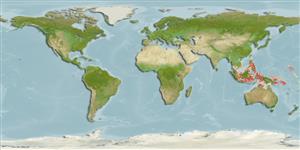>
Gobiiformes (Gobies) >
Gobiidae (Gobies) > Gobiinae
Etymology: Trimma: Greek, trimma, -atos = something crushed (Ref. 45335); agrena: Name from Greek "agrenon" meaning a net, referring to the mesh-like pattern on the body formed by the strongly outlined scale pockets; noun in apposition..
More on authors: Winterbottom & Chen.
Environment: milieu / climate zone / depth range / distribution range
Écologie
marin récifal; profondeur 2 - 20 m (Ref. 90102). Tropical
Western Pacific: Malaysia, the Philippines and Indonesia.
Taille / Poids / Âge
Maturity: Lm ? range ? - ? cm
Max length : 2.1 cm SL (female)
Épines dorsales (Total): 6 - 7; Rayons mous dorsaux (Total): 8-10; Épines anales 1; Rayons mous anaux: 8 - 9. Distinguished by the combination of the following features: no predorsal scales anterior extension of body scales along the side of the nape from half-way between the eye and the shoulder spot in juveniles to just behind the eye in adults; body light brown with orange spots or stripes on the head, a dark greyish orange shoulder spot above pectoral fin base, and scale pockets strongly outlined with dark brown chromatophores with an orange spot at the junction between adjacent pockets in the same longitudinal row (Ref. 51083).
Inhabits reef crevices and caves in 2-20 m (Ref. 90102).
Life cycle and mating behavior
Maturité | Reproduction | Frai | Œufs | Fécondité | Larves
Winterbottom, R. and I.-S. Chen, 2004. Two new species of Trimma (Teleostei: Gobiidae) from the western Pacific Ocean. Raffles Bull. Zool. 11(Sup.):103-106. (Ref. 51083)
Statut dans la liste rouge de l'IUCN (Ref. 130435)
Menace pour l'homme
Harmless
Utilisations par l'homme
Plus d'informations
Noms communsSynonymesMétabolismePrédateursÉcotoxicologieReproductionMaturitéFraiRassemblement de ponteFéconditéŒufsDéveloppement de l'œuf
RéférencesAquacultureProfil d'aquacultureSouchesGénétiqueElectrophoresesHéritabilitéPathologiesTraitementNutrientsMass conversion
CollaborateursImagesStamps, Coins Misc.SonsCiguateraVitesseType de nageSurface branchialeOtolithesCerveauxVision
Outils
Articles particuliers
Télécharger en XML
Sources Internet
Estimates based on models
Preferred temperature (Ref.
123201): 28.4 - 29.3, mean 28.8 °C (based on 732 cells).
Phylogenetic diversity index (Ref.
82804): PD
50 = 0.5000 [Uniqueness, from 0.5 = low to 2.0 = high].
Bayesian length-weight: a=0.01023 (0.00477 - 0.02194), b=3.02 (2.84 - 3.20), in cm total length, based on LWR estimates for this (Sub)family-body shape (Ref.
93245).
Résilience (Ref.
120179): Haut, temps minimum de doublement de population inférieur à 15 mois (Preliminary K or Fecundity.).
Fishing Vulnerability (Ref.
59153): Low vulnerability (10 of 100).
Nutrients (Ref.
124155): Calcium = 416 [178, 1,466] mg/100g; Iron = 1.91 [0.79, 4.31] mg/100g; Protein = 18 [16, 20] %; Omega3 = 0.162 [0.049, 0.523] g/100g; Selenium = 31.5 [9.0, 93.9] μg/100g; VitaminA = 114 [21, 603] μg/100g; Zinc = 5.11 [2.68, 8.76] mg/100g (wet weight);
